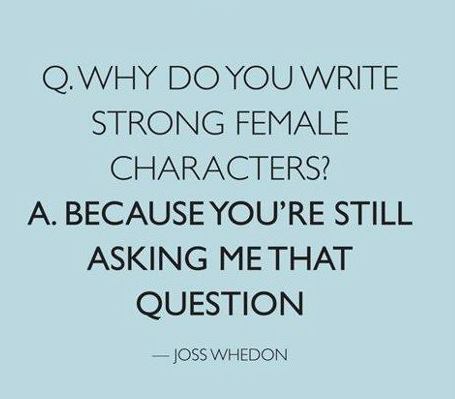Sophia McDougall’s August article in the New Statesman, I hate Strong Female Characters really struck a chord with me. Two weeks after reading it, I’m still talking about it, so something must have clicked. McDougall’s central argument revolves around ‘the patronising promise of the Strong Female Character’ – presented as anomalous (i.e. this character is special because she’s strong and ‘normal women are weak and boring and can’t do anything worthwhile’) and ultimately one-dimensional. McDougall’s questions why we are expected to be accepting of and excited by SFCs because they kick ass or break the mould of previous archetypes like whores and god’s police. Is one dominating character trait enough, even if it differs from previously normative traits? McDougall points out that merely being ‘strong’ is a fairly small and uncomfortable box that believable and well-written male characters aren’t expected to be confined to.

Why celebrate SFCs when that is as good as it gets? When in contrast, male protagonists are not only strong, but also intelligent, moody, vulnerable, abrasive, Bohemian, whimsical, neurotic, sad, vain, rude, courteous, artistic and the list of contradictory adjectives goes on. Just because the SFC isn’t a sex kitten or a nun or puts up with/cuts to pieces the cards that she’s dealt doesn’t mean she isn’t still a one-dimensional side kick to the real action.

Of course male characters are not necessarily perfect, portrayed with real depth or breaking the archetypal moulds of old either, and gender is only one lens through which to criticise the imbalance of archetypes and uneven spread of multifaceted protagonists (race and sexuality provide interesting lenses too, to name a few). However, McDougall’s argument that the SFC is a facade hiding old tropes is well founded. I find this particularly interesting when thinking about the creation of new archetypes. How do you create new archetypes? What happens when the audience and other creators don’t have the pop-cultural vocabulary to interpret new archetypes?
Recently, watching an interpretation of a female protagonist in a short play I wrote, this was particularly striking. The actor’s instinct was to dramatise and become almost hysterical when reading the words I wrote, and although I am all for the process of interpretation (in fact I think it’s vital in theatre) I baulked at it. The whiny and melodramatic 17-year-old I saw on stage wasn’t what I thought I had written. Of course, this portrayal was valid and my ideas about how a 17-year-old young woman might respond to a situation probably vary wildly from the next person’s. This wasn’t what irked me. What got in my grill was that in my view the actor was falling back on previous experiences of how other people had portrayed 17-year-old young women, and rather than interpreting her as a person through what was on the page, this actor was falling back on the framework of what she thought a 17-year-old young woman should be.
I’m not sure that there is a solution to these gaps in intention and interpretation, but I hope that actors, directors and audiences are open to exploring new archetypes with greater depth and human contradiction rather than falling back on what they have seen before, or what they think female characters ‘should be’.
